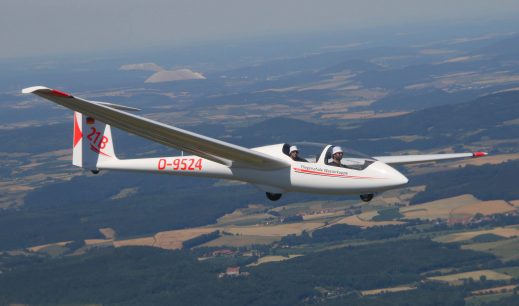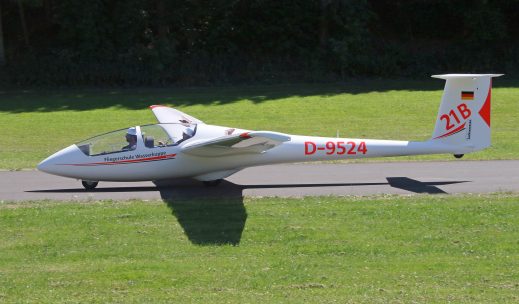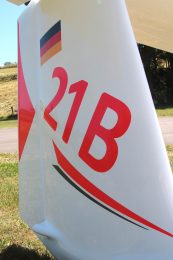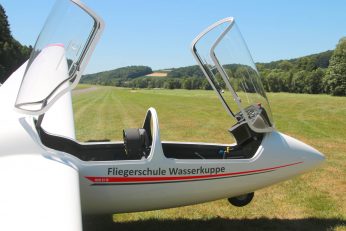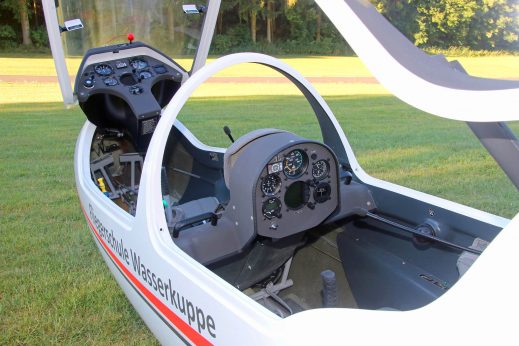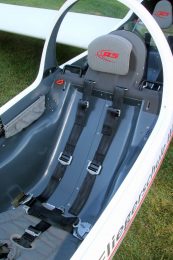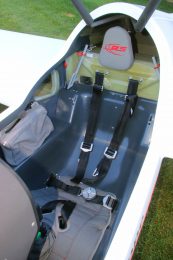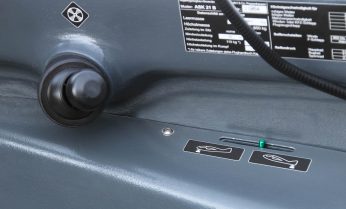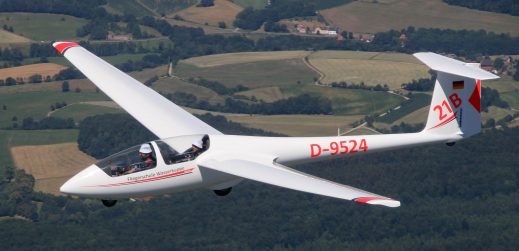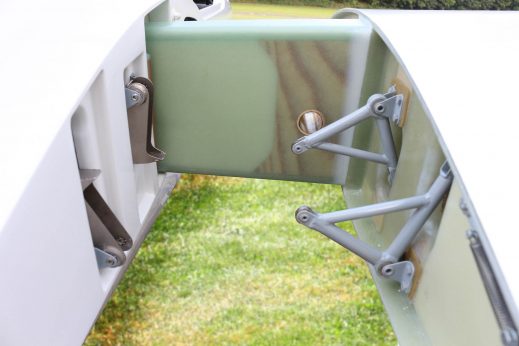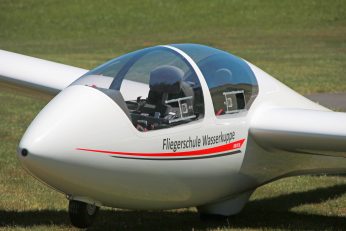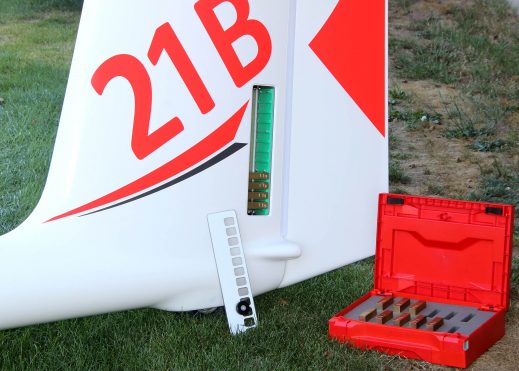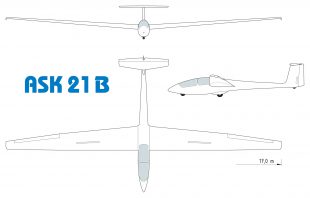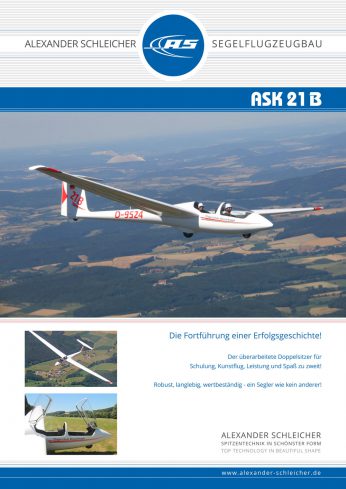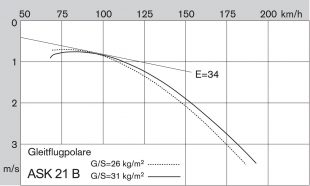- The continuation of a success story.
- Instruction, aerobatics, performance, fun to fly for two up!
- Robust, durable, stable in value - a Trainer like No Other!
The ASK 21 is a mid-wing two-seater with 17m span. No other 2-seater has turned a larger number of students into solo pilots and no other glider has carried more new pilots through their first flight and cross country training to competition flying.
The backbone of every club is a reliable fleet of training aircraft. With the ASK 21 instructors get a training tool that puts enjoyment and fun back into flight training.
From ASK 21 to ASK 21 B
The result of careful further development is now called ASK 21 B. Without changing the basic character of the aircraft, we have implemented some new ideas and changes particularly in the fuselage.
New cockpit seat pans offer more room for large pilots and provide even more comfortable and safer seating positions. All controls are now automatically connected when rigging the glider.
This characterizes the ASK 21 B:
- The wide operating range, from instruction and training, the first cross-country or competition flights up to aerobatics and cloud flying.
- Extremely forgiving low speed behaviour and flight characteristics. A low wing loading of only 24.5 kg/m² (at a payload of 85 kg) gives the ASK 21 the ability to climb even in the weakest thermals.
- Its easy ground handling due to the low tail weight and low all-up weight. When empty, the glider is finely balanced on its main wheel eliminating the need for a tail dolly for ground handling.
- The comfortable entry and exit due to the front hinged canopy and up-swinging instrument panel, as well as additional clearance of the rear canopy.
- While on the ground the aircraft rests on both main and nose wheel, aiding directional stability during take-off and landing runs wich eases trainee workload.
- The low all-up weight also pays off for winch launches where considerably more height is gained compared to bigger and heavier two-seaters. This is a pre-condition for an effective training operation in flying circuits or for reaching thermals.
- The now larger 380 mm fixed main wheel and generously dimensioned damping elements forgive harder landings on uneven terrain and protect the backs of instructors and students.
- The tail wheel is fitted as standard.
- A flexible seal for the mainwheel cut-out prevents dirt from entering the fuselage.
- The former brake system has been replaced by a sealed version so that even during frequent inverted flying air cannot enter the system.
- High quality construction. The ASK 21 / ASK 21 B is the first sailplane with a possible life span of 18,000 hours.
Redesign of the cockpit
- The double wall FRP honeycomb construction of the ASK 21 B cockpit lowers the structural weight and at the same time provides a higher degree of passive safety due to the specially formed seat pans and optimized safety belt attachment points.
- Activation of the front canopy emergency release due to an easily operated lever system.
- The rear instrument support was moved further back which resulted in a larger front cockpit. In both cockpits the control stick was moved further forward which is particularly beneficial for larger pilots.
- The carrier for the rear instrument panel has also been completely re-worked. The new design improves visibility to the sides of the panel. Grab bars to ease entry and exit are also provided. At the same time the rear pilot has more room in the knee area.
- Easily adjustable seatbacks provide the necessary flexibility for both cockpits. As well, the front rudder pedals have a greater range of adjustment.
- Adjustable head rests in the front and rear cockpit.
- Energy absorbing, colour coordinated and easily removable cushions provide a high degree of comfort.
- Side storage pockets for both cockpits are now standard.
- The new trim indicator on the right side of the seat pan is clearly visible.
- New ventilation outlets are easier to adjust and aim and also reduce the noise level.
Automatic connections also on the wing
- Smooth and low force steering provides fatigue-free flying even on long flights. Large, very effective air brakes on the upper wing surfaces permit steep landing approaches.
- Automatically connected elevator and wing control surfaces.
- An improved roll rate as a result of higher aileron effectiveness will be of particular interest to aerobatic pilots.
- A new pitot tube in the nose makes the previously required pitot extension for aerobatic flight unnecessary.
- Lighter pilots will appreciate the simplified installation of the trim weights using a new fitting just ahead of the front seat pan.
- Two battery fittings in the wings are now standard equipment.
- The aileron and elevator gaps are now sealed and covered with Mylar tape as standard equipment.
Spin ballast in the fin
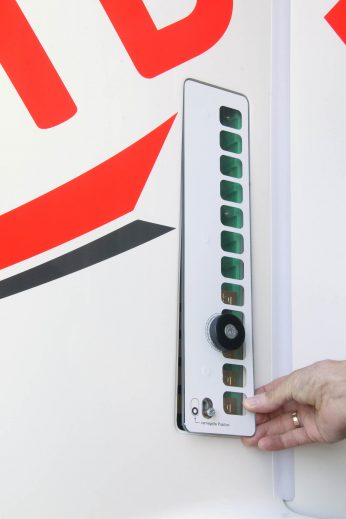
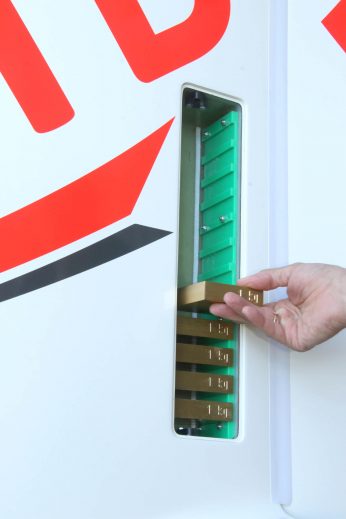
- Spin weights are now cube-shaped brass weights placed into a receptacle box integrated into the fin.
The predecessor model already set new standards for sailplane training with regard to value retention and reliability combined with minimal service requirements for the customer.
After the over 950 ASK 21s built so far, we are happy to make this proven aircraft even better. We are proud to hear pilots say after their first flight with the ASK 21 B:
„It flies like a 21, it is a 21 – but it’s even better.“
Then we will have done everything correctly.
Photos: Manfred Münch

